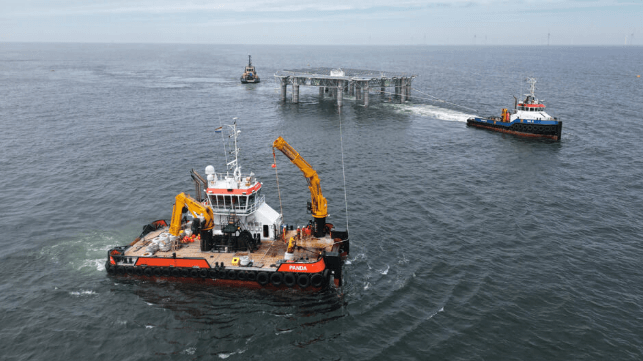The Merganser project has been successfully installed in the Dutch North Sea as a first step towards testing and demonstrating the technology. Developed by Dutch-Norwegian joint venture SolarDuck with support from RWE, the project will monitor its performance while exploring the possibility of integrating solar PV into offshore wind farms.
German energy giant RWE said two years ago that it was considering integrating floating solar technology into offshore wind farms to make more efficient use of seawater for energy production. The company said it was attracted to the concept as a way to address the growing scarcity of land for renewable energy production and as an alternative in areas unsuitable for wind power.
“Offshore floating solar PV, either alone or in combination with offshore wind farms, has the potential to open up further opportunities for offshore renewable energies, especially for countries with low average wind speeds but high sunshine,” said Sven Utermolen, CEO of RWE Offshore Wind.
RWE has won the auction for the Hollands-Kust (West) wind farm zone in the Netherlands for 2022. As part of the project, the company proposed to integrate SolarDuck’s solutions to meet the bidding requirements. SolarDuck was commissioned to develop a demonstration system, and other options in the auction included incorporating batteries into the offshore wind farm and using space on the site for offshore hydrogen production.
Merganser has a maximum power output of 0.5 megawatts. The project, which consists of six interconnected platforms, was towed approximately 7.5 miles off the coast of Scheveningen. The floating platforms were successfully connected to a mooring system in water 20 meters (65 feet) deep.
One of the main challenges is developing a platform that can withstand harsh offshore conditions. The North Sea is known for its strong winds and high waves. SolarDuck’s triangular platform is designed to float several meters above the water’s surface. The company says the design keeps critical components dry, clean and stable, ensuring the structural integrity of the semi-submersible floating structure. The design recently received the world’s first certification for OFPV from Bureau Veritas.
Over the next two years, the Merganser will be remotely monitored by more than 180 sensors that will report on structural loads, connector and mooring loads, and electrical performance. The companies said the tests will provide critical information for the development and commercialization of the technology.
The Hollandse Kust (West) wind zone has two projects, one developed by RWE and the other awarded to a consortium of Shell and Eneco. The zone is located about 30 miles off the west coast of the Netherlands. Split into two projects, the wind farms will have a generating capacity of about 1,400 MW and are expected to be operational by the end of 2026.

